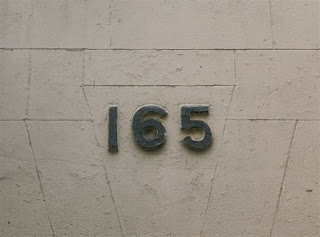
#153, Lower East Side, NYC
The Quality of Life Task Force: four sweatshirts in a bogus taxi set up on the corner of Clinton Street alongside the Williamsburg Bridge off-ramp to profile the incoming salmon run; their mantra: Dope, guns, overtime; their motto: Everyone's got something to lose.
So begins the prologue of Richard Price's 2008 novel Lush Life. I am so in love with the language, the characters, the world of this book that I could eat it up like a late-night falafel. I don't read crime fiction, but I love film noir and I have been known to get sucked into a Raymond Chandler pot-boiler on occasion (not to mention the Brooklyn Paper's police blotter, which I've riffed on before). So the experience of reading this book - a crackling good tale set in NYC's Lower East Side full of wisecracking cops, conflicted bystanders, hipster blow-ins, vanishing Virgin Mary apparitions in Yemenite delis, and police procedurals - has been like getting sucked into the world's best Law & Order marathon, only better, because it's a book. And fitting, because Price, in addition to churning out some amazing novels, has won an Edgar award for his work writing for the HBO series The Wire.
Want more? Here's how Price opens chapter 2:
At 4:00 a.m., the first to come on the scene were Lugo's Quality of Lifers on the back end of a double shift, still honeycombing the neighborhood in their bogus taxi, but as of 1:00 a.m. on loan to the Anti-Graffiti Task Force, a newly installed laptop mounted on their dashboard running a nonstop slide show of known local taggers.
There's an art to these sentences. It's part hard-hitting journalism - answering who, what, where, when, why, and how in a one-two punch - part fine-tuned word selection ("honeycombing the neighborhood") and part attitude. When I see the phrase "bogus taxi" I already can hear a Sam Spade-like voice in my head, channeling all the hard-boiled private investigators I've accumulated in fictions over the years. It borrows devices from newspapers, rags, and pulp fiction to set up scenes and keep the plot hurtling along. And yet there is a music to this writing that is all Price's own. I'm only up to page 94, but I've had to put the book down I don't know how many times just to relish the sentences.
If there's one thing I'm learning from reading this novel, it's how gratifying simple details can be. I tend to overuse similes in my own rough drafts and have to pry them out later with a good editor's wrench, but one thing New York reminds you of (though this is true anywhere), is how you don't have to compare anything to anything else. The thing itself is enough. For example, here's a street scene from just a few hours ago, free of embellishment, just the facts, ma'am:
Nine o'clock at night in the subterranean subway station at West Fourth Street, waiting for a downtown F train. An echo of a melody rings out, diabolical and frantic, and at the helm of the xylophone is a guy in fur, a head-to-toe Pepe Le Pew suit zipped up the back, skunk tail and all, a hot pink scarf wound around his neck, hot pink knock off Ray Bans clamped over his skunk headgear. With his paws he clamps two mallets: soft-edged, fuzzy, making the sticks vibrate with the speed of his playing. A dishwater blond commuter, dressed in pale blue windbreaker, drops a dollar in his instrument case then disappears into a Coney Island/Stillwell Av bound D train. He cracks a woodblock, grins.
And that's the pleasure of reading a good book. It makes you look at your environment and notice more closely. I could've written off what I saw a few hours ago in the short-hand irony of "Hipster dressed as skunk plays music in subway - freak show." And to some extent, mentally, I did. But then it's more fun to really look, listen, experience, and describe, than to just roll your eyes or snap a pic and call it a night. Though it's a big, exhausting, overwhelming city, so there's a time and place for that, too.



































